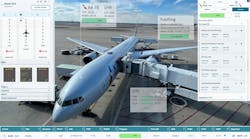Airports around the world are currently engaging in all forms of social media marketing, from prompting passengers to upload photos from the airport to Facebook to blogging about the many features and amenities that each terminal has to offer. Many airports, and their marketing teams, are building massive fan bases and using social media to promote many facets of the airports services, including retail outlets, duty free stores and public transport infrastructure. Social media has also proved valuable in offering real time customer service via announcements about flight delays, highway/transit closings and special flight pricing.
The most social media savvy airports have taken their social media games to the next level by offering promotional material and even running viral campaigns via Twitter and Facebook. Some of the most creative and effective campaigns have been run by Singapore’s Changi Airport. They currently have over 298,000 fans on Facebook, over 12,000 Twitter followers, and over 120,000 fans on Sina Weibo, the primary Chinese social media platform. Other airports notable for their use of social media and the quality of their social content include Melbourne International Airport, London Gatwick Airport and Kuala Lumpur Airport. To find out more about how airports are using well-known social media platforms to increase passenger engagement and increase their “brand’ awareness, please refer to the slides below:
What are airport marketers to do though, when these familiar social media platforms are not widely used by passengers, or not accessible in the passengers’ home country, as is the case with travelers from China? As China’s middle and upper classes continue to expand, more and more travelers will set out from China for locales the world over. In 2012, Chinese tourists notched over 80 million international trips and spent over $100 billion dollars abroad, indicating that they are a market segment worth catering to. These travelers by-and-large do not use Facebook or Twitter and thus won’t be affected or engaged by content and campaigns hosted therein.
To capitalize on this growing group of passengers, airports must add Chinese social media platforms into their marketing mix. Given the levels of internet penetration in China, prevalence of social media among many classes and the rapid adoption of smartphones by mobile users across the country, Chinese travelers are no strangers to social media marketing. The Beijing Airport has over 460,000 followers on Sina Weibo and the Hangzhou Airport has over 620,000 followers on the same platform. Every day, Chinese travelers interact and receive information about travel from these airports. These travelers, and their peers who venture abroad tend to travel with their smartphones and tablets and use their devices to share news, photos and all-important peer-generated feedback with friends and contacts all over the world.
In order to connect with these travelers, airports and marketers must speak their language and speak where—and on which platforms—these travelers are likely to spend their social media time. Creating a social media marketing plan that includes Sina Weibo and Tencent’s WeChat, among other platforms, and using digital marketing to reach this massive market will be critical for airports looking to make strides in attracting Chinese passengers. Airports that become “China Friendly” can expect to see an increase in traffic from mainland China and in turn see increased revenue from these connected Chinese travelers.
There are four social media marketing strategies that can help airports become “China Friendly”. The first one is Advocacy. Advocacy by those who have experienced a product or service has always been the biggest driving force behind gaining new customers. Showing others who have traveled through the airport is an important step in building trust. The next step is Social Care; today’s connected travelers are keen to get information on the go and are not shy to vent their frustration in an instant. Giving travelers an online space to discuss issues and receive advice will allow you to better manage your brand. Step three Story Telling; socially caring airports build memorable, long-lasting bonds with the community using storytelling. Letting travelers know your brand story will allow them to identify with your value proposition. Step four Crowdsourcing; online platforms offer unprecedented opportunities for inviting customer participation and tapping into great ideas for product innovation. These four tips will help create a better traveling experience for the connected Chinese travelers.
The implications are clear; the airports that wish to keep up with the rapidly changing hospitality and travel industries must follow them onto the Chinese social media platforms. Today, airports (just like other companies) need a strong presence on the Chinese internet and specifically on Chinese social media platforms. Airports that embrace this trend first will benefit the most. There is a golden opportunity for airports to capture the hearts and minds of Chinese travelers, which will return for years to come.



